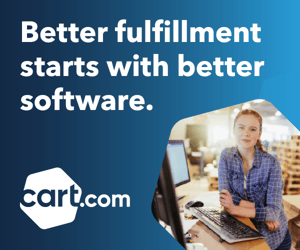Successful retailers understand that the key to reaching sales goals lies in engaging customers wherever they are; and modern consumers discover, shop and purchase through a wide variety of channels. To illustrate, 58% of U.S. consumers purchased a product after seeing it on social media in 2023, while 49% of shoppers say they use Google to discover or find a new item or product. There is no one-size-fits-all approach to ecommerce – making it critical to diversify how you reach and sell to customers while learning what works best for your brand and audience.
Maximizing your ecommerce reach requires an omnichannel strategy. It also means learning, understanding and having the ability to use multiple channels to market and sell. This guide will give you a deeper understanding of omnichannel retail and multichannel selling on platforms like Amazon, Walmart, Google and Facebook.
Multichannel selling: Unlocking new avenues for growth
What is multichannel selling? As the term suggests, it simply refers to the practice of selling your retail products across more than one channel. A selling channel can include any of the following:
- Your branded website
- Your branded app
- Social media sites like Facebook, Instagram and TikTok
- Online marketplaces like Walmart, Google and Amazon
By leveraging multiple sales channels, businesses can reach a broader audience, increase brand visibility and cater to the diverse preferences of their customers, reaching more customers and converting at a higher rate.
Using an omnichannel strategy for multichannel selling
Because online shopping makes conducting product research easier, most buyers gather information across channels before they make a purchase. Their activities often include comparing different brands and prices, assessing quality, reading reviews and evaluating features. A Harvard Business Review study found that 73% of online shoppers used multiple channels before making their retail purchases. To support this multichannel customer journey, brands adopt an omnichannel strategy.
Diversifying your sales and marketing channels and using an omnichannel strategy offers important benefits for your retail business, including:
- Increased brand awareness and market presence as shoppers see your brand and products across various channels.
- Higher visibility and a broader reach.
- Adaptability and lower risk since you aren’t relying on a single platform’s success for your entire business.
- Improved customer experience through enhanced accessibility and added purchase options.
- Added revenue through reaching additional customers and segments that may have been absent in a single-channel model.
When you’re ready to expand sales channels, evaluating the various options available and their suitability for your business model is essential. This involves analyzing factors such as target audience demographics, product characteristics and competition to determine the most effective channels for reaching potential customers. Once you've identified promising sales channels, the next step is to develop a comprehensive strategy for each, including setting up accounts, optimizing product listings and implementing marketing tactics to attract and engage your audience effectively.
Crafting your presence on Amazon: Strategies for success
Showing up strategically on Amazon is an excellent way to boost the success of your retail business. However, gaining traction on Amazon requires careful planning and ongoing optimization of ads, product listings and brand presence. One of the most impactful strategies for Amazon success is creating product listings specifically optimized for the Amazon marketplace and search engine. You can do this by:
- Creating compelling and informative product listings: Attract potential customers and ensure that your products are found via search. Optimize product listings using high-quality images, write clear and persuasive product descriptions and incorporate relevant keywords. Amazon's search algorithm relies heavily on keywords, so understanding your target audience's search behavior is essential.
- Utilize Amazon advertising: From Sponsored Products and Sponsored Brands to Sponsored Display, there are various advertising types to choose from within the Amazon platform. Crafting targeted and compelling ad campaigns can increase product visibility, especially for new or lesser-known products.
- Strengthen supply chain strategy: Develop a strong supply chain that addresses demand planning, storage monitoring and FBA shipment creation and tracking. The goal is to provide customers a more flexible, efficient and reliable post-purchase experience.
Amazon hosts a large ecommerce platform, and it takes careful planning and maintenance to make it work. Whether you decide to go manage it yourself or invest in marketplace management, Amazon can be an excellent sales channel to add to your mix.
Walmart: Tapping into the retail giant's ecosystem
Selling products through retail channels like Walmart gives your customers additional features and can positively impact your overall business. Retailers can create a Walmart Marketplace Seller Account in minutes without paying monthly fees or undergoing a complex setup. To get your product in front of the most customers on the Walmart selling platform, ensure that your product listings adhere to Walmart’s guidelines. Elements that help product descriptions rank well include:
- Clear titles
- Descriptive listings
- High-quality images
- Helpful attributes
- Competitive prices
- In-stock items
- Positive customer reviews
Walmart's Listing Quality dashboard makes it easy for retailers to manage their listings and visibility. To broaden your reach, try Walmart's advertising and promotional tools.
Google Shopping: Enhancing visibility in product searches
For many online shoppers, the first step to finding the right product is conducting a quick Google search. That’s why it’s imperative to include Google Shopping in your multichannel selling strategy. Listing on Google means your products show up not only on Google Search, but also in Google Maps searches and on YouTube. Creating a Merchant Center account is free and easy to connect with a Business Profile where applicable.
When your products or business appear in a Google Search, customers can check out through Google or click the product listing and land directly on your ecommerce site or marketplace storefront. Listing with Google will also provide insight into ways you can increase traffic. Link to Google Analytics to gather data on website traffic, user behavior and conversions. By analyzing this data, you can identify patterns, understand customer preferences and pinpoint areas for improvement. This information can then be used to tailor marketing strategies, optimize website content and enhance the overall shopping experience to attract more visitors and increase traffic.
Promoting products with Google Ads is also a great way to boost sales. With Google’s Performance Max, retailers can promote products across various platforms with a single campaign. Drive conversions through streamlined and easily managed ad campaigns using AI tools and an integrated platform.
Facebook: Getting started with social commerce
The average person spends almost two and a half hours on social media every day, and nearly half (47%) of U.S. shoppers have made purchases through social media. When aiming to reach customers where they are, placing your products on social media platforms is critical. An excellent channel to start with is Facebook Shop.
To start selling on Facebook, you can create a Facebook Shop:
- Set up a Facebook Page for your business if you don't already have one.
- Access the Commerce Manager through your Facebook Page settings.
- Follow the prompts to set up your shop, including adding product listings, setting up payment and shipping options and configuring your shop's settings.
- Once your shop is set up, you can start promoting your products through posts, ads and other marketing efforts to attract customers to your Facebook Shop.
- Manage your orders and customer inquiries through the Commerce Manager to ensure smooth transactions and customer satisfaction.
You can also explore other Facebook selling options, such as Facebook Marketplace for local selling or integrating third-party ecommerce platforms with Facebook for more advanced selling capabilities.
Integrated tools between Facebook and Instagram mean you can double your outcomes for the same amount of effort by leveraging targeted ads on both platforms. Simply create and set up your ad on Facebook and choose settings that deliver the ads to Instagram as well. Social media advertising allows for in-depth targeting and analytics, which can help you better understand your target audience and best customers. What’s more, keeping up a positive and engaging social media presence can help boost your brand image and keep customers engaged with your message.
Uniting your channels with an omnichannel retail strategy
An omnichannel retail strategy integrates your sales channels seamlessly to provide customers with a unified shopping experience across online and offline touchpoints. Retailers can implement several key strategies to support multichannel selling with an omnichannel approach:
- Invest in a robust technology infrastructure: Enable real-time inventory visibility across all channels, allowing customers to access accurate product availability information regardless of the sales channel they use. This ensures a consistent shopping experience and reduces the risk of stockouts or overstocking.
- Prioritize customer data collection and analysis: Gain insights into customer preferences, behaviors and purchasing patterns across different channels. This information can inform personalized marketing campaigns and product recommendations tailored to individual customer needs, enhancing engagement and driving sales.
- Offer flexible fulfillment options: To accommodate diverse customer preferences and provide convenience, provide options such as buy online, pick up in-store (BOPIS), or ship from store. Look into streamlining your supply chain to support multichannel selling. This can be done through a hybrid order fulfillment approach, leveraging omnichannel fulfillment providers, FBA and more.
By leveraging the strengths of each channel and creating synergies between them, retailers can maximize their reach. This strategy also helps forge partnerships with providers that further optimize your efforts.
Cart.com for multichannel selling and omnichannel strategies
Cart.com unifies your commerce efforts with solutions that work together. For brands looking to expand sales channels, our commerce services span growth marketing, marketplace management, store optimization and more. Contact our expert team today to get started on new channels and create a cohesive, engaging omnichannel experience.







